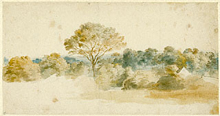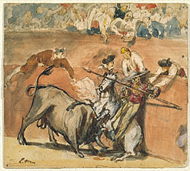|
This exhibition traces the development of watercolor as an artistic medium and documents the inventive techniques of several great watercolorists.
The ingredients of watercolor are simple: cakes or tubes of paints, brushes, water, and paper. Enormous skill, however, is required to master the medium. The greatest watercolor artists developed unique and inventive ways of manipulating pigment, water, and the paper underneath.
|
 |
|
Flemish artist Anthony van Dyck, whose Landscape is shown above, pioneered the use of translucent watercolor washes. The artist allowed the blank paper to shine through the pigment, playing as important a role as the watercolor itself. From van Dyck's time on, watercolorists viewed their medium as an interaction between color and paper.
|
 |
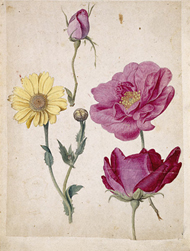
 |
 |
A Sheet of Studies with French Roses and an Ox-Eye Daisy, Jacques Le Moyne de Morgues, about 1570
Recent Acquisition
|
 |
 |
Water-soluble paints date back to the dawn of history. The paint we call watercolor, a mixture of water, ground pigment, and gum Arabic (sap from the acacia tree), had its beginnings in the late 1400s. This was the time of a great explosion of scientific exploration in Europe. Well suited to field studies because of its portability, watercolor quickly became popular for landscapes and natural history studies.
Early natural history illustrators tried to create the illusion of reality. These flowers by French artist Jacques Le Moyne de Morgues pop off the page as if they were three-dimensional. To explore the rose in detail, the artist rendered it in bud and bloom from two vantage points. Le Moyne de Morgues was one of many artists who accompanied explorers to the New World to record the wondrous flora and fauna encountered there.
|
 |
 |
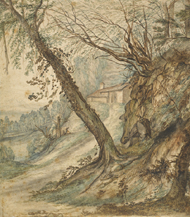
 |
 |
Wooded Landscape, Lucas Achtschellinck, about 1640–1650
Recent Acquisition
|
 |
Increasing naturalism and the development of watercolor went hand in hand. Achtschellinck's scene is full of details from nature such as gnarled tree roots and green strands of ivy. The cottage in the middle distance evokes the mountain architecture of Switzerland and Italy, and the blue in the background suggests an atmospheric haze.
|
 |
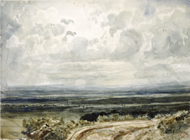
 |
 |
View of a Valley in Normandy, Paul Huet, 1825–1830
Recent Acquisition
|
 |
 |
Watercolor gained in popularity and prestige starting around 1780. Landscape artists in Britain led the way, expanding upon the tradition of using watercolor to record nature. The founding of the Society of Painters in Watercolours in London in 1804 signaled that watercolorists were gaining acceptance as serious artists.
This scene captures the character of the countryside in northern France. Artist Paul Huet exploited the transparency of watercolor to show sunlight breaking through clouds over a valley. He achieved the streaming light effects by adding yellow washes over the blue he had used for the clouds.
|
 |
 |
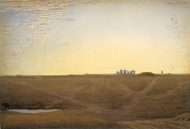
 |
 |
Stonehenge at Twilight, William Turner of Oxford, about 1840
Recent Acquisition
|
 |
 |
|
William Turner of Oxford worked exclusively in watercolors and made several views of Stonehenge. Here he used dense, wet strokes for the landscape, blotting the paper to create the gently rolling hills.
For the spectacular sunset, Turner of Oxford used thin washes to create a subtle gradation from purple to yellow.
|
 |
|
Watercolor reached new artistic heights in the late 19th century. Works in watercolor from this time are characterized by brilliant color and bold brushstrokes also occurring in oil painting with the rise of Impressionism and Post-Impressionism. The late 19th century saw the growing prestige of watercolor as an artistic medium, which freed artists from having to compete with oil painting.
Édouard Manet, a precursor of Impressionism, pushed watercolor to a new level of looseness and expression. In the center of this scene, a snarl of graphite conveys the horrific goring of the horse's belly. Dots of salmon pink, yellow, and other pastel colors evoke the cheering crowd.
|
 |
 |
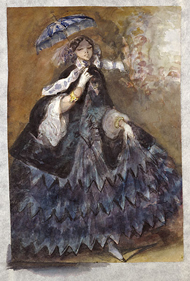
 |
 |
Woman with a Parasol, Constantin Guys, 1860s
Recent Acquisition
|
 |
Constantin Guys was praised by author and critic Charles Baudelaire as the "painter of modern life" for his portrayal of fashionable Parisian women.
Guys created highly finished sheets, such as this figure of a woman, for exhibition and sale. He exploited the translucent quality of watercolor to suggest the gown's layers of sheer fabric.
The exhibition is located at the Getty Center, Museum, East Pavilion.
|
 |
